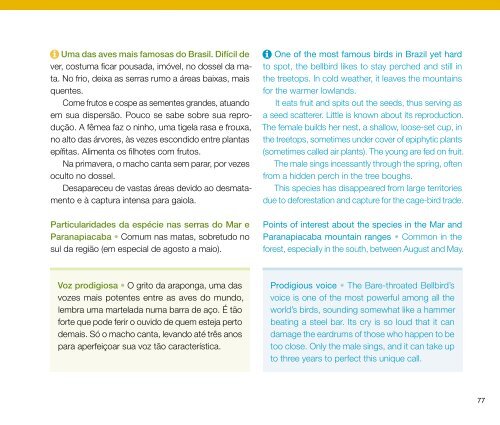Guia de aves Mata Atlântica Paulista - Secretaria do Meio Ambiente
Guia de aves Mata Atlântica Paulista - Secretaria do Meio Ambiente
Guia de aves Mata Atlântica Paulista - Secretaria do Meio Ambiente
You also want an ePaper? Increase the reach of your titles
YUMPU automatically turns print PDFs into web optimized ePapers that Google loves.
Uma das <strong>aves</strong> mais famosas <strong>do</strong> Brasil. Difícil <strong>de</strong><br />
ver, costuma ficar pousada, imóvel, no <strong>do</strong>ssel da mata.<br />
No frio, <strong>de</strong>ixa as serras rumo a áreas baixas, mais<br />
quentes.<br />
Come frutos e cospe as sementes gran<strong>de</strong>s, atuan<strong>do</strong><br />
em sua dispersão. Pouco se sabe sobre sua reprodução.<br />
A fêmea faz o ninho, uma tigela rasa e frouxa,<br />
no alto das árvores, às vezes escondi<strong>do</strong> entre plantas<br />
epífitas. Alimenta os filhotes com frutos.<br />
Na primavera, o macho canta sem parar, por vezes<br />
oculto no <strong>do</strong>ssel.<br />
Desapareceu <strong>de</strong> vastas áreas <strong>de</strong>vi<strong>do</strong> ao <strong>de</strong>smatamento<br />
e à captura intensa para gaiola.<br />
Particularida<strong>de</strong>s da espécie nas serras <strong>do</strong> Mar e<br />
Pa ranapiacaba • Comum nas matas, sobretu<strong>do</strong> no<br />
sul da região (em especial <strong>de</strong> agosto a maio).<br />
One of the most famous birds in Brazil yet hard<br />
to spot, the bellbird likes to stay perched and still in<br />
the treetops. In cold weather, it le<strong>aves</strong> the mountains<br />
for the warmer lowlands.<br />
It eats fruit and spits out the seeds, thus serving as<br />
a seed scatterer. Little is known about its reproduction.<br />
The female builds her nest, a shallow, loose-set cup, in<br />
the treetops, sometimes un<strong>de</strong>r cover of epiphytic plants<br />
(sometimes called air plants). The young are fed on fruit.<br />
The male sings incessantly through the spring, often<br />
from a hid<strong>de</strong>n perch in the tree boughs.<br />
This species has disappeared from large territories<br />
due to <strong>de</strong>forestation and capture for the cage-bird tra<strong>de</strong>.<br />
Points of interest about the species in the Mar and<br />
Paranapiacaba mountain ranges • common in the<br />
forest, especially in the south, between August and May.<br />
Voz prodigiosa • O grito da araponga, uma das<br />
vozes mais potentes entre as <strong>aves</strong> <strong>do</strong> mun<strong>do</strong>,<br />
lembra uma martelada numa barra <strong>de</strong> aço. É tão<br />
forte que po<strong>de</strong> ferir o ouvi<strong>do</strong> <strong>de</strong> quem esteja perto<br />
<strong>de</strong>mais. Só o macho canta, levan<strong>do</strong> até três anos<br />
para aperfeiçoar sua voz tão característica.<br />
Prodigious voice • The Bare-throated Bellbird’s<br />
voice is one of the most powerful among all the<br />
world’s birds, sounding somewhat like a hammer<br />
beating a steel bar. Its cry is so loud that it can<br />
damage the eardrums of those who happen to be<br />
too close. Only the male sings, and it can take up<br />
to three years to perfect this unique call.<br />
77

















